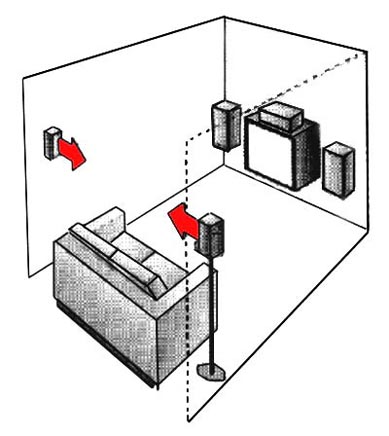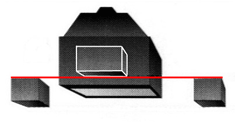| Phone: (919) 341-9037 |
Surround sound and home theater placement
5.1 and 6.1 Surround Sound Speaker Placement And Surround Speakers
When putting together a Dolby digital 5.1 home theater system, you should ensure that the five main loudspeakers-left, center, right, and two surrounds can reproduce the same sound. Loudspeakers that have perfectly matched timbre (generally those using the same or similar tweeters and woofers and crossover design) will give the best results. However, the main speakers do not have to reproduce low bass. With a good subwoofer dedicated to reproducing low bass and adjusted for the best integration with the main loudspeakers, it can be virtually impossible for you to determine which of the speakers is reproducing low bass. You could use large floor standing loudspeakers that are capable of reproducing low bass, but that is not necessary, because you can achieve excellent results with five small satellite loudspeakers and a dedicated subwoofer.
You will hear different opinions about where to place your rear surround loudspeakers. The ideal placement is on adjacent walls above the listening area as shown in the graphic below. The surround loudspeakers may be wall-mounted. Where wall mounting is undesirable, you can place the loudspeakers on loudspeaker stands or use small floor standing towers. Another alternative is to use pivoting adjustable brackets (such as Omnimount) to mount the loudspeaker on the ceiling and angle them downward over the listening area.

However, there are good alternatives in placing your rear surrounds.
(click here for basic stereo loudspeaker placement)
(click here for optimal stereo loudspeaker placement)
6.1 Surround Speakers And Surround Speaker Placement
A 6.1 surround speaker system adds a center channel loudspeaker in the rear for a more revealing sound. Any of the small loudspeakers mentioned above for rear surround use may be used as a rear center channel loudspeaker. In addition you may use a loudspeaker designed for center channel use.

Surround Speakers
First, lets clear up a misperception, that only specially designed loudspeakers, such as THX certified loudspeakers, can work well in surround or home theater systems. Nothing could be farther from the truth. And the various arguments for such loudspeakers are mostly marketing ploys. For certain, if you intend to use a loudspeaker near (generally, less than a foot and a half) from a CRT screen such as a TV, you must use a shielded loudspeaker to prevent magnetic interference from the magnet that is on the transducers (drivers) in the loudspeaker from reaching the CRT.
Magnetic interference will cause color distortion and can permanently damage CRTs. Some small loudspeakers can be used less than a foot from a CRT and not produce any magnetic interference, because of the small magnets they use. The bottom line is that if you don't intend to place the loudspeakers very close to the CRT, they do not have to be magnetically shielded.
Buy the highest quality loudspeakers you can afford. Remember loudspeakers are the most critical pieces of equipment in the chain of the equipment that forms your home theater system. Any small Role Audio loudspeaker will do. By highest quality I mean: well designed and well constructed, not pricey. A high quality loudspeaker should produce neutral coverage of the frequency spectrum. It should radiate sound fairly evenly in all directions. And it should reproduce a stereophonic image and soundstage accurately.
Center Channel Speaker Placement
A high quality accurate center channel loudspeaker such the Role Audio Discovery that radiates the sound evenly will let you hear voices clearly and centered in your home theater system. The center loudspeaker has to be accurate because it is reproducing all the information produced by the other loudspeakers in addition to dialogue. Without the center channel speaker only the person in the "sweet spot" tends to hear dialogue that is centered. For other listeners the dialogue will drift towards the speaker they are sitting closest to. Your center channel loudspeaker should be "timbre-matched," with the left and right front speakers.
The Center channel loudspeaker should be placed in line with the front loudspeakers or in line with the back of of the main loudspeakers.


The center channel loudspeaker is generally placed directly above the TV. It may also be placed directly below it. It is generally desirable to place the center loudspeaker so that the tweeter of the center loudspeaker "lines up with" the tweeters of the two main loudspeakers.



